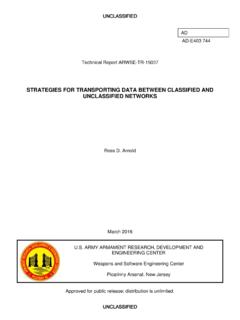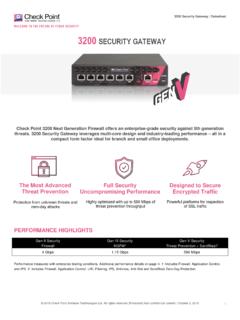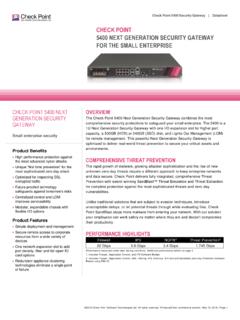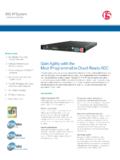Transcription of Cisco Integrated Services Routers—Performance …
1 White Paper 2010 Cisco and/or its affiliates. All rights reserved. This document is Cisco Public Information. Page 1 of 7 Cisco Integrated Services routers performance Overview What You Will Learn The Cisco Integrated Services routers Generation 2 (ISR G2) provide a robust platform for delivering WAN Services , unified communications, security, and application Services to branch offices. These platforms are designed to support existing WAN access circuits and offer the performance needed for the transition to Ethernet-based access Services . This document discusses the performance architecture of the Cisco ISR G2 and provides specific performance information from a variety of service configurations and test use cases.
2 The goal is to help you understand performance data points and how to use them. The performance information in this document is divided into two sections. The first section provides details about some maximum performance values, and the second presents a set of data to be used for production network design. Architecture for Integrated Services and performance Cisco ISRs are designed to deliver Integrated Services at high performance for the branch office. The platforms run Cisco IOS Software on a central CPU using a shared memory pool, allowing the processor to dynamically allocate memory for required functions and Services .
3 The ISRs have two pieces of function-specific hardware: ! An embedded encryption processor: The encryption processor provides hardware-based acceleration for IP Security (IPSec) (using Triple Digital Encryption Standard [3 DES] or Advanced Encryption Standard [AES]) and Secure Sockets Layer (SSL) VPNs. For IPSec encryption, the acceleration chip performs the actual mathematical encryption, while relying on the router CPU to identify traffic for encryption, negotiate the security associations, and forward packets. Thus, the encryption chip offloads part of the overall process the mathematically intensive part but the CPU is still involved in the overall processing and forwarding of encrypted traffic.
4 ! Packet voice/fax DSP module 3s (PVDM3s): These chips provide dedicated resources for audio conferencing, transcoding, and public-switched-telephone-network (PSTN) connectivity. Again, the chips are specialized for these purposes, but still rely on the router CPU to forward packets to and from them. The multicore CPU on the Cisco ISR G2 platforms runs classic Cisco IOS Software. Since Cisco IOS Software is a single threaded operating system, only a single core is active. In most test cases, router performance is governed by a combination of available CPU cycles and how features are processed in the software.
5 No Drop Rate and RFC-2544 Tests routers have traditionally been tested using RFC 2544 or similar types of performance tests. RFC 2544 requires tests to be run at a no drop rate (NDR). This testing is done by using a fixed packet size, usually 64-byte packets, and the results are usually published as a metric in kilopackets per second (kpps). The tests are designed to show the CPU power and processing power of the platform (Table 1). White Paper 2010 Cisco and/or its affiliates. All rights reserved. This document is Cisco Public Information. Page 2 of 7 Another popular technique for providing router performance information is also an NDR test, but it is performed with maximum packet size and presented as a throughput test.
6 Results are delivered as megabits per second (Mbps). This test yields a maximum data-rate forwarding of specific features. Table 1. Cisco ISR G2 RFC 2544-Based performance (kpps and Mbps) Platform Cisco 860 Cisco 880 Cisco 890 Cisco 1921 Cisco 1941 Cisco 2901 Cisco 2911 Cisco 2921 Cisco 2951 Cisco 3925 Cisco 3925E Cisco 3945 Cisco 3945E kpps (64-byte packets) 25 50 100 290 330 330 352 479 579 833 1845 982 2924 Mbps (1500-byte packets) 197 198 1400 2770 2932 3114 3371 3502 5136 6903 6703 8025 8675 For NDR tests sometimes the platforms can process and forward packets faster than the aggregate bandwidth of the interfaces that the specific models can support.
7 In this situation, all available interfaces are driven to line rate and CPU usage recorded. What these tests do not provide is any indication of how the router will perform in a production environment. They assume that router CPUs scale linearly to the point where they drop packets. The tests provide no means for analyzing router Services , software-based algorithms, or other features. There is no ability to account for real protocols, application layer gateways (ALGs), or other real-world traffic. Also, production networks tend to have varied packet sizes. Voice traffic and TCP acknowledgements (ACKs) tend to be very small packets, generally 64 to 80 bytes.
8 File transfers and some applications tend to use as large a packet size as they can negotiate. Thus, NDR tests with fixed packet sizes do not provide a very realistic look at router performance in a production environment. Cisco IOS Software Security Services and performance Security performance can be grouped into two categories secure connectivity and threat defense. Secure connectivity includes IPSec and SSL VPN technologies. From a performance perspective, threat defense focuses on firewall technology. For IPSec, the focus is on throughput and scalability. IPSec throughput is measured using a single tunnel with 1400-byte packets, with no Secure Hash Algorithm (SHA) or Message Digest Algorithm 5 (MD5) authentication.
9 The packet size must be reduced to account for the additional packet headers when using IPSec. With regard to secure connectivity, the United States government maintains very strict control on the export of strong cryptography, from both technology and performance standpoints. As with many other products, the Cisco ISRs are subject to this regulation. In order to comply with this policy, both the temporary and permanent Security (SEC) licenses are limited in both performance and tunnel count. The limitation is applied to cumulative encrypted tunnel counts and concurrent throughput. Encrypted tunnels are defined as IPSec, SSL VPN, or Secure Real-Time Transport Protocol (SRTP).
10 Currently that limitation is 170-Mbps throughput (85 Mbps in each direction) and 225 tunnels. This limit is enforced and cannot be exceeded with the SEC license. The High- performance Security (HSEC) license allows full scalability in both performance and connections. Table 2 gives performance information for IPSec and SSL VPN by platform. White Paper 2010 Cisco and/or its affiliates. All rights reserved. This document is Cisco Public Information. Page 3 of 7 Table 2. IPSec Maximum performance by Platform Platform Cisco 860 Cisco 880 Cisco 890 Cisco 1921 Cisco 1941 Cisco 2901 Cisco 2911 Cisco 2921 Cisco 2951 Cisco 3925 Cisco 3925E Cisco 3945 Cisco 3945E IPSec Mbps (SEC license only, no HSEC needed) 46 102 125 149 170 170 170 IPSec Mbps (SEC + HSEC license) 207 282 770 1494 848 1503 A second data point for performance testing on secure connectivity technologies is maximum connections.






